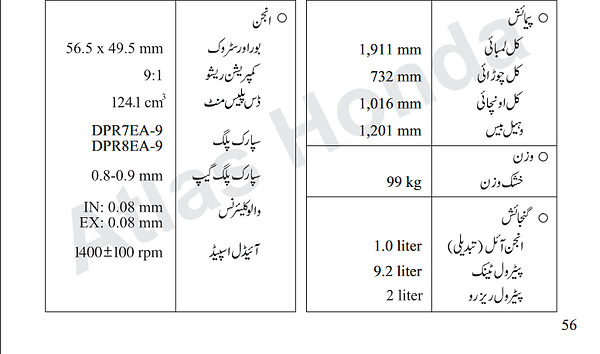
How to choose the right Octane Fuel For Motorcycle
here are recommended octane ratings for other motorcycles
Honda cd70 old model
Honda cd70 2022 or new model
Honda pridor
Honda cg125
Suzuki gd110
Yamaha ybr 125
Honda cb150f
Suzuki gds150
Suzuki gr150
87 to 92
87 to 96
87 to 96
87 to 96
87 to 96
92 to 100
87 to 96
87 to 96
87 to 96
87 to 96
How to find the right octane for your motorcycle: t
To determine the appropriate octane rating for your motorcycle, the simplest approach is to consult the owner's manual. Within its pages, you'll discover the manufacturer's recommended octane level for fuel, as well as any other relevant fuel-related guidelines, such as whether your motorcycle engine can operate on leaded or unleaded fuel.
Prior to 2015, when the Yamaha YBR125 was introduced, many motorcycles in Pakistan featured low-compression engines that did not require high-octane fuel. However, newer models like the Honda CD70, released from 2022 onwards, boast higher compression ratios, such as 9.5:1. With the availability of higher-octane fuel in Pakistan, more motorcycles may derive benefits from its use.
Nevertheless, whether your motorcycle necessitates high-octane fuel depends on its specific specifications. It's crucial to ascertain the appropriate octane level for your motorcycle's engine to ensure optimal performance and longevity.
The initial specification to consider is the compression ratio of an engine.
In a 4-stroke engine, there are four distinct phases:
-
Intake
-
Compression
-
Power
-
Exhaust
Following the intake phase, where the fuel and air mixture enters the cylinder, compression precedes ignition by the spark. Compression brings the air and fuel molecules closer together, increasing their temperature for a more effective combustion process.
The compression ratio is expressed as a ratio such as 10:1 or 9.5:1, signifying the relationship between the volume of the cylinder when the piston is at the bottom of its stroke (maximum volume) and when it's at the top (minimum volume).
Fuels are rated in octane and RON (Research Octane Number), with higher octane ratings indicating better resistance to premature combustion or knocking. However, why is there a need to resist combustion when the objective is to combust the fuel mixture? The reason lies in preventing knock, a condition where the fuel ignites prematurely due to compression alone, resulting in potential engine damage.
Using high-octane fuel in a low-compression engine may result in unburnt fuel and exhaust gases that can obstruct the catalytic converter, foul spark plugs, and diminish power output. Conversely, utilizing low-octane fuel in a high-compression engine can induce knocking. Therefore, selecting the appropriate fuel type is crucial for achieving proper combustion timing.
Here's a guideline for recommended octane ratings corresponding to engine compression ratios:
-
Low compression (e.g., < 9:1): Regular octane (typically 87 RON)
-
Medium compression (e.g., 9:1 to 10:1): Mid-grade octane (e.g., 89-91 RON)
-
High compression (e.g., > 10:1): Premium octane (typically 91+ RON)
It's important to recognize that the octane rating doesn't signify the fuel's power potential; rather, it denotes its resistance to knocking.
Compression ratio to octain chart
Compression ratio |
Recommended octane
5:1
6:1
7:1
8:1
9:1
10:1
11:1
12:1
72
81
87
87-92
89-96
92-100
96-104
100-108
To ascertain the appropriate octane fuel for a Honda CG125, refer to the owner's manual and locate the section where Atlas Honda specifies the engine's compression ratio. For the Honda CG125, the compression ratio is noted as 9:1. Upon comparing this ratio to the previously provided chart, we deduce that the recommended octane range falls between 89 to 96 RON. Consequently, any octane fuel within this specified range is suitable for use in the Honda CG125.

For the Yamaha YBR125, equipped with a 10:1 compression ratio engine, the suggested octane range is between 92 and 100. Nevertheless, it is particularly advised to utilize fuel with an octane rating ranging from 95 to 100 to ensure peak performance and maintain engine health.
